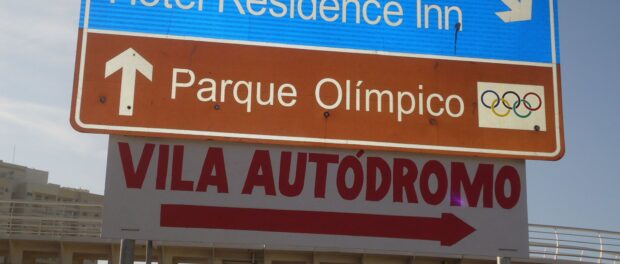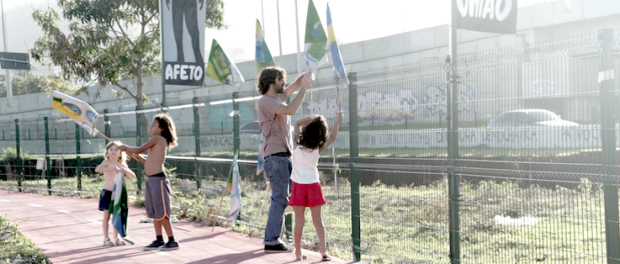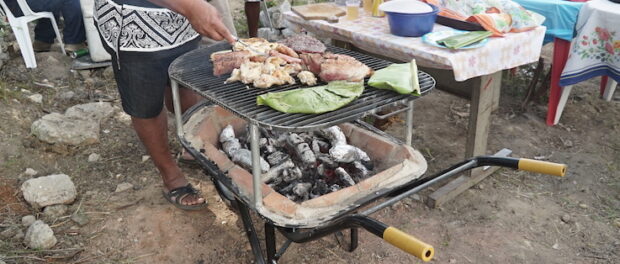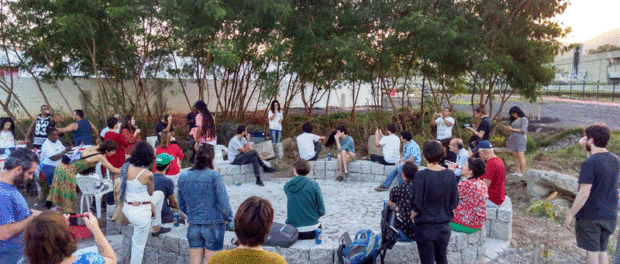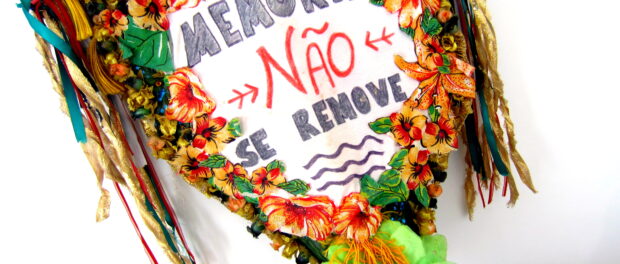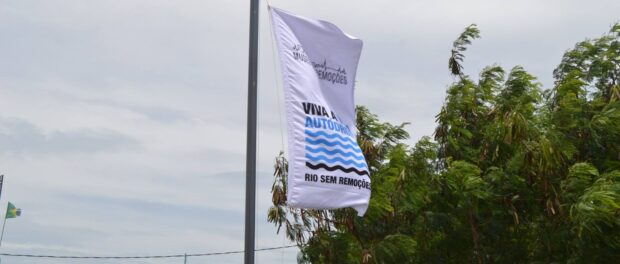
“The house was knocked down, Maria da Penha was not.” It was with this phrase, repeated numerous times in a video projected on the wall of the Urban Studies House, that a public talk about the Céu Aberto (Open Air) project began last Tuesday, November 7. The phrase denotes the memory of Vila Autódromo that lives on in the bodies and the struggle of its residents, of whom Maria da Penha is perhaps the most well-known. Developed by the residents of the West Zone community of Vila Autódromo jointly with a group of artists, architects, researchers, and curators, the Céu Aberto project is part of an initiative of the Goethe-Institut in six Latin American cities called The Future of Memory. The initiative aims to articulate memory in historical processes of State violence, armed conflicts, and movements of social resistance, seeking to challenge the official narratives and contribute to local struggles.
“The fight is not over. Vila Autódromo was made up of a big family that was unfortunately divided. But we managed to lift ourselves up and create a new family with all of our supporters. And now is the time to honor the struggle of each resident who fought for the community, and each supporter. Everything was always done collectively and with love here. When we held a protest stopping traffic, we thought about how we could make the situation more agreeable for those who had nothing to do with this. We made breakfast to serve out, explaining the cause, why we were causing the disruption, and we had a very nice exchange. A protest with a coffee and a biscuit brings a smile. It’s a struggle with love, with joy,” Maria da Penha summarized.
Artistic and urban interventions in the community were developed out of the workshops held with residents to stimulate the recovery of symbols and memories, to understand the projections and desires for that urban space, and to stimulate corporal expression. These interventions integrated the Evictions Museum, an open-air museum that uses the remains of the demolished houses and the waste from abandoned construction work to tell the story of those who are not usually remembered in the official history. It is a museum that has a site, but which also exists beyond its walls, in the street, in the rubble, and in the bodies and in the voice of each resident and supporter of the struggle.
One result of the workshops was the recovery of the memory of a Brazilian flag: in one episode the City ordered the flag be taken down as officials interpreted its presence at a community birthday party as a protest. The flag, which previously held no greater symbolism for the residents than for any other Brazilians, became an element of the resistance. Multiple flags were then produced, and today they serve both to sustain memory and to fulfill an aesthetic function of visibility, signaling to drivers passing by on the surrounding express lanes that a community exists—small and almost invisible amid its concrete surroundings. The initial idea was just to mount one sign with the purpose of signaling the existence of Vila Autódromo to those who passed by, but in the participatory workshops it became clear that there were other symbolic spaces to be disputed.
Another important dimension of the project was taking back the public spaces erased by city government’s intervention, which removed the children’s play area, reduced the green space, and did away with the corners of the community, viewed as meeting places, by transforming the area into one single street. In order to do this within the available budget, the decision was made to build a portable barbecue as a form of urban furniture that would allow residents to take back that particular public space, especially symbolic due to the history of collective barbecues promoted during the community’s cultural occupation and resistance events. The project team also decided to build a square. The choice to build a square out of stone reflected a point vocalized by Sandra Maria, one of the leaders of the resistance in the community there at the time, that even though the budget was small, the residents did not want anything temporary; they wanted something fixed, which would be a permanent feature of the environment.
The project also involved a mapping of the archive of images taken by Luiz Cláudio Silva, a resident and activist documentarian, as he was defined by the project participants. On examining the thousands of photographs that documented the process of the struggle as well as the joys, and in trying to map the logic of their organization, the participants noticed the photos were organized in folders according to the name of the event where they were taken, the name of someone celebrating a birthday, a symbolic date, an element that distinguishes the community from others, or the name of a specific resident. They came to the conclusion that the guiding element of this catalog was affection, and so labeled it an ‘affective cartography.’
“For more than a year I’ve been in the presence of these new people in the community and it was lovely. The project was made with love. We created a strong bond, which doesn’t have a price: of care, fraternity, compassion, understanding, embracing, and sharing. We learn a little bit of architecture, art, music. It is a great exchange. I hope that this work continues in other communities and gives them a voice, and that we can continue working collectively and growing this big family,” Maria da Penha said. These visits and conversations where compiled in a glossary publication entitled “vocabularies in movement /\ lives in resistance.”
The remaining residents of Vila Autódromo are still resisting. This resistance is strongly evident in the symbolic plane of memory. Memory to not forget the hundreds of families that were removed, the houses that were demolished, a history of threats of removals dating back to 1992, and the process of resistance to the Olympic cycle of removals that lasted around six years. “Our history, our rights, our housing don’t have a price. Not everyone was able to stay because the struggle is very cruel, very unequal, and very exhausting. I fought and never went with hate. It was difficult, but I did not leave. I continue here firm and strong. The little cheeky one, right?” said Maria de Penha with her characteristic good humor.

